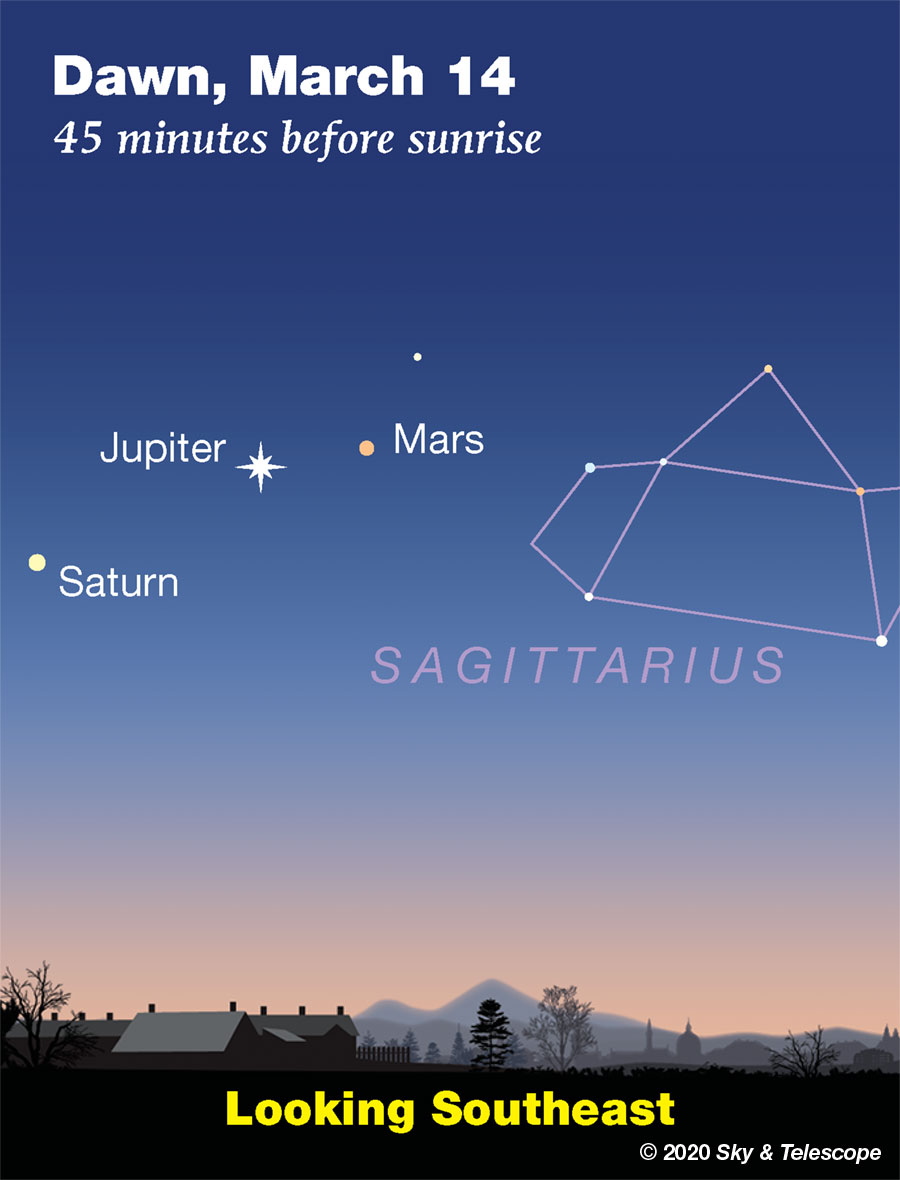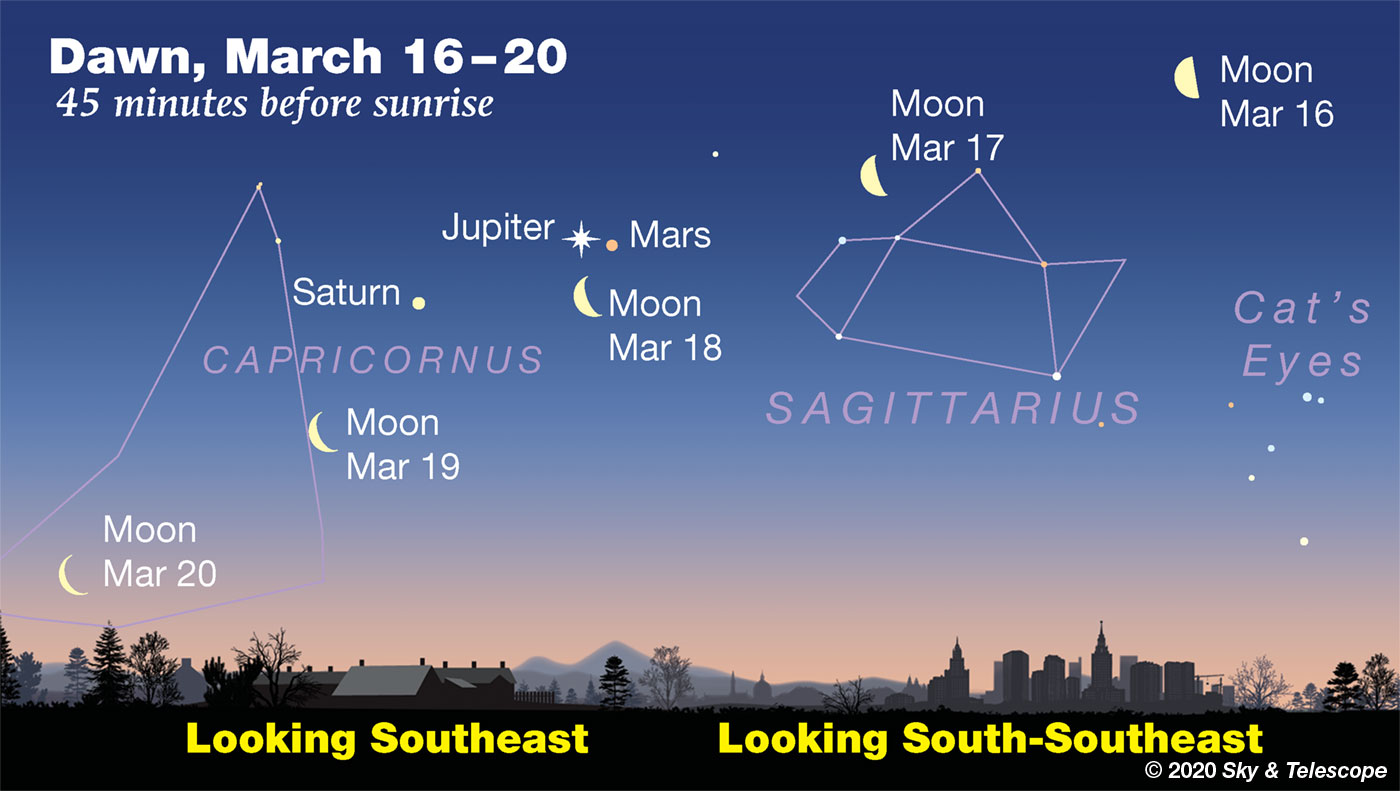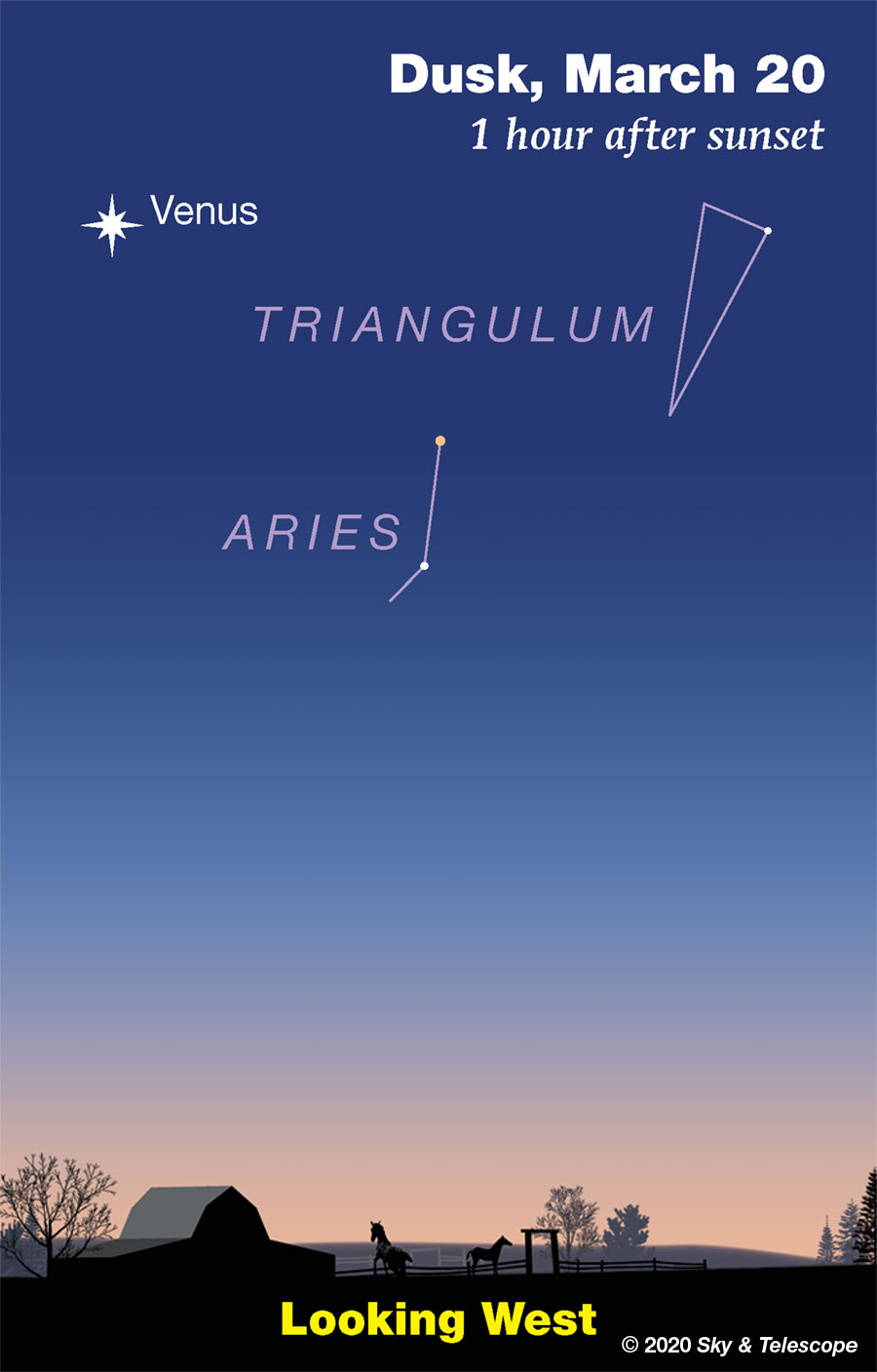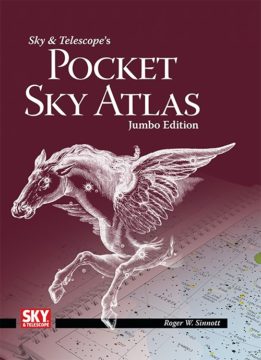Betelgeuse is rebrightening. After bottoming out at about V magnitude +1.64 in early to mid-February, Orion's Betelgeuse was up to +1.1 as of March 18th. The change from minimum is obvious to the eye.

Friday, March 13
• Venus continues to shine high in the west at nightfall, unchanging for many weeks on end. But meanwhile, the starry background slides toward the lower right behind it.
For instance, not long ago the Pleiades were very high above Venus, but as of this evening they've closed to 21° apart (about two fists at arm's length). The Pleiades are heading toward Venus by about 1° per day. Their left edge will encompass the dazzling planet on the evening of April 3rd.
Saturday, March 14
• Right after dark, five carnivore constellations stand upright in a row, from the northeast to south. They're all seen in profile with their noses pointed up and their feet (if any) to the right. They are Ursa Major the Big Bear in the northeast (with the Big Dipper as its brightest part), Leo the Lion in the east, Hydra the Sea Serpent in the southeast, Canis Minor the Little Dog higher in the south-southeast (lit by Procyon), and bright Canis Major the Big Dog lower in the south (lit by Sirius).
Sunday, March 15
• Last-quarter Moon tonight (exactly so at 5:34 a.m. Monday morning the 16th EDT). The Moon rises tonight around 2 or 3 a.m. daylight-saving time, at the dim border of Ophiuchus and Sagittarius. By early dawn Monday the 16th the Moon is higher in the south, above the tail of Scorpius and upper right of the Sagittarius Teapot as shown below.

Monday, March 16
• Sirius shines brilliantly in the south-southwest after dark. Lower left of it, by about one fist, is the triangle of Adhara, Wezen, and Aludra, from right to left. They form Canis Major's hind foot, rear end, and tail, respectively.
Just left or upper left of these three, forming a 3rd- and 4th-magnitude arc, are the three uppermost stars of the constellation Puppis. No, Puppis is not a puppy, despite following behind the Big Dog. It's the Poop Deck (stern) of the giant ancient constellation Argo Navis, the ship of Jason and the Argonauts. These three stars the only stars of Argo readily visible naked-eye from mid-northern latitudes.
Just 1.4° upper right of the middle of the three, binoculars on a dark night will show the 6th-magnitude open cluster M93.
Tuesday, March 17
• Two clusters under Sirius. Spot Sirius again right after dark, while it still blazes high south-southwest. In binoculars it's a white-hot dazzlement. Binoculars will also show, south of it by 4°, the 5th-magnitude smudge of the open cluster M41. That's a little less than the width of a typical 7- to 10-power binocular's field of view.
And south-southeast of there, by 3.6°, you'll find the 4th-magnitude orange star Omicron-1 Canis Majoris. Around it is a very loose scattering of fainter stars: a mixture of the young stellar association Canis Major OB2 and the smaller, background cluster Collinder 121. Does the blend of them suggest a hint of a faint fuzzy object to you? See Matt Wedel's Binocular Highlight column in the March Sky & Telescope, page 43.
• In early dawn of Wednesday the 18th, the Moon forms a tight triangle with Jupiter and Mars just 2° or 3° over it, as shown in the sky scene above.
Wednesday, March 18
• More about Sirius and Canis Major. In a very dark sky the Big Dog's realistic stick figure is plain to see — the dog is in profile prancing to the right on his hind legs, with Sirius as his shiny dog tag — but for most of us only his five brightest stars show well through the light pollution. These form the unmistakable Meat Cleaver. Sirius and Murzim (three finger-widths to its right) are the wide front end of the cleaver, with Sirius sparkling on its top back corner. The triangle of Adhara, Wezen, and Aludra to Sirius's lower left is the cleaver's other end, including its short handle. It chops toward the lower right.
Thursday, March 19
• We cross the equinox at 11:50 p.m. EDT (3:50 March 20th UT). Spring begins in the Northern Hemisphere, fall in the Southern Hemisphere. Wherever you are, the Sun rises almost due east and sets almost due west.
Day and night are supposed to be equal now (equinox means "equal night"), but that's only if you define "night" as beginning and ending the moment when the center of the Sun's true unrefracted disk crosses your true horizon. Most people wouldn't say it's "night" until the world is pretty dark, an hour or so after sunset.
• On the traditional divide between the winter and spring sky is the dim constellation Cancer. It's high on the meridian in early evening, between Gemini to its west and Leo to its east.
Cancer holds something unique: the Beehive Star Cluster, M44, in its middle. Look for it a little less than halfway from Pollux in Gemini to Regulus in Leo. The Beehive shows dimly to the naked eye if you have little or no light pollution. With binoculars it's easy, even under worse conditions.
• Algol shines at its minimum light, magnitude 3.4 instead of its usual 2.1, for a couple hours centered on 10:40 p.m. Pacific Daylight Time. Algol takes several additional hours to fade and to rebrighten.
Friday, March 20
• Look for Arcturus, the Spring Star, very low in the east-northeast after nightfall and higher in the east later in the evening. By modern measurements Arcturus is visual magnitude –0.05, making it the fourth-brightest nighttime star. It's bested only by Sirius, Canopus, and Alpha Centauri (combining the light of Alpha Cen A and B; the pair appears single to the unaided eye).
For northerners who can never see Canopus or Alpha Cen, Arcturus is bested by Sirius alone. However, Vega and Capella are very close on its heels.

Saturday, March 21
• The Big Dipper glitters softly high in the northeast these evenings, standing on its handle. You probably know that the two stars forming the front of the Dipper's bowl (currently on top) are the Pointers; they point to Polaris, currently to their left.
And, you may know that if you follow the curve of the Dipper's handle out and around by a little more than a Dipper length, you'll arc to Arcturus, now rising in the east.
But did you know that if you follow the Pointers backward the opposite way, you'll land in Leo?
Draw a line diagonally across the Dipper's bowl from where the handle is attached, continue far on, and you'll go to Gemini.
And, look at the two stars forming the open top of the Dipper's bowl. Follow this line past the bowl's lip far across the sky, and you cruise to Capella.
This Week's Planet Roundup
Mercury is having a poor apparition low in the glow of dawn. Look for it very low above the east-southeast horizon about 30 minutes before sunrise, far lower left of Jupiter, Saturn, and Mars. Binoculars help; Mercury is not particularly bright, growing only from magnitude +0.6 on the morning of March 14th to +0.2 on the 21st.
Venus (magnitude –4.4, in Aries) is the big, bright "Evening Star" shining high in the west during and after twilight. Venus doesn't set until some 2½ hours after the end of twilight.
In a telescope, Venus is now almost at dichotomy (appearing half-lit) and 22 arcseconds in diameter. It will continue to enlarge in size and wane in phase for the next two months, becoming a dramatically thin crescent in May.
Mars, Jupiter, and Saturn (magnitudes, +1.0, – 2.0, and +0.7, respectively) group low in the southeast as dawn begins. Jupiter is by far the brightest. Mars moves eastward closer to Jupiter every day. On the morning of March 14 it's 3° from Jupiter, as shown at the top of this page. They pass 0.7° apart on the morning of the 20th.
Uranus (magnitude 5.9, in Aries) is getting lower in the west after dark, ever farther below Venus.
Neptune is hidden behind the glare of the Sun.
All descriptions that relate to your horizon — including the words up, down, right, and left — are written for the world's mid-northern latitudes. Descriptions that also depend on longitude (mainly Moon positions) are for North America.
Eastern Standard Time (EST) is Universal Time (UT, UTC, GMT, or Z time) minus 5 hours.
Want to become a better astronomer? Learn your way around the constellations. They're the key to locating everything fainter and deeper to hunt with binoculars or a telescope.
This is an outdoor nature hobby. For an easy-to-use constellation guide covering the whole evening sky, use the big monthly map in the center of each issue of Sky & Telescope, the essential guide to astronomy.

Once you get a telescope, to put it to good use you'll need a detailed, large-scale sky atlas (set of charts). The basic standard is the Pocket Sky Atlas (in either the original or Jumbo Edition), which shows stars to magnitude 7.6.
Next up is the larger and deeper Sky Atlas 2000.0, plotting stars to magnitude 8.5; nearly three times as many. The next up, once you know your way around, are the even larger Interstellarum atlas (stars to magnitude 9.5) and Uranometria 2000.0 (stars to magnitude 9.75). And read how to use sky charts with a telescope.
You'll also want a good deep-sky guidebook, such as Sue French's Deep-Sky Wonders collection (which includes its own charts), Sky Atlas 2000.0 Companion by Strong and Sinnott, or the bigger Night Sky Observer's Guide by Kepple and Sanner.
Can a computerized telescope replace charts? Not for beginners, I don't think, and not on mounts and tripods that are less than top-quality mechanically (meaning heavy and expensive). And as Terence Dickinson and Alan Dyer say in their Backyard Astronomer's Guide, "A full appreciation of the universe cannot come without developing the skills to find things in the sky and understanding how the sky works. This knowledge comes only by spending time under the stars with star maps in hand."
![]() Audio sky tour. Out under the evening sky with your earbuds in place, listen to Kelly Beatty's monthly podcast tour of the heavens above. It's free.
Audio sky tour. Out under the evening sky with your earbuds in place, listen to Kelly Beatty's monthly podcast tour of the heavens above. It's free.
 5
5








Comments
Pencil BFB
March 14, 2020 at 1:35 am
Now is the time to stargaze from your window or terrace, due to the COVID-19 outbreak. In Metro Manila, community quarantine measures were imposed to last for a month, and curfew from 8:00 PM to 5:00 AM was started too. For now, let's just temporarily postpone or cancel astronomical gathering within the next few months. Hope the outbreak ends soon.
And speaking of Manila, from there Canopus culminates 23 degrees over the southern horizon and Alpha Centauri 15 degrees over the horizon. The entire former constellation of Argo Navis (that is, Puppis, Vela, and Carina) is also visible from Manila. Its southernmost bright star, Miaplacidus (Beta Carinae) is 6 degrees above the horizon at its highest.
You must be logged in to post a comment.
Rod
March 14, 2020 at 9:53 am
Pencil BFB, thanks for the update. Enjoy some time stargazing, and be safe. I was going to get up early this morning and view Mars, Jupiter, and Saturn. However, I rolled over in bed, briefly looked at the window and rolled over back to sleep 🙂
You must be logged in to post a comment.
cyrtonyx
March 19, 2020 at 10:28 am
Rod,
Have you seen Mercury this month? A challenge this apparition to be sure. I saw it this morning ( 19th) very low to the lower left of the trio of the other morning planets. I have a very flat and clear eastern horizon to work with, Needed my bins though to see it in the rising glow of dawn.
You must be logged in to post a comment.
Rod
March 16, 2020 at 11:41 pm
mary beth, hope you are preparing for 20th (Friday) early morning views when Mars catches Jupiter. I have been tracking for sometime now. I was out early this morning with clear skies and colder temperature 0C. [Observed 0545-0645 EDT. Sunrise 0715 EDT. Last Quarter Moon 16-Mar-20 at 0934 UT/0534 EDT. Good views of Mars closing in on Jupiter this morning. Using 10x50 binoculars, I could see both in same FOV and Ganymede moon with Jupiter. Using the 90-mm refractor with 14-mm, I could see Jupiter and all 4 Galilean moons, Jupiter cloud belts too. Saturn, rings, and Titan moon visible in the telescope view. Early morning 20-Mar-20, Mars will pass by Jupiter < 1-degree from the planet. Weather permitting I should be able to see both planets at 71x with a bit more than 1-degree true FOV. Mars this morning distinct planetary disk shape near 6" angular size and orange-red hue. Using the 10x50 binoculars, the Last Quarter Moon view very nice with many craters along the terminator line.]
My location now for early Friday morning looks mostly cloudy. Perhaps you can enjoy the view 🙂
You must be logged in to post a comment.
Rod
March 18, 2020 at 1:31 pm
The ecliptic, especially SE sky early this morning was something to see where I view from (clear skies and temperature 2C) in Maryland. I trust others in the Sky & Telescope community enjoy the early morning show too. Jupiter, Mars, waning crescent Moon, and Saturn. Great photo opportunity and wonderful ecliptic in SE sky! I was out 0545-0715 EDT, sunrise near 0713 EDT. From my stargazing log this morning, [Observed 0545-0715 EDT. Sunrise 0713 EDT. Starry Night Sky Calendar for 18-March-2020 "March 18, 2020 Wednesday Crescent Moon near Mars and Jupiter (pre-dawn) In the southeastern sky before dawn on Wednesday, March 18, the waning crescent moon will take up a position 1.5 degrees to the south of Mars and Jupiter. All three objects will fit into the field of view of binoculars (red circle) and will make a lovely widefield photograph when composed with nearby Saturn and some interesting foreground terrain. Hours earlier, from approximately 6:40 to 7:40 UT, observers in southern South America, South Georgia, Antarctica, and the Kerguelen Islands will see the moon occult Mars." This was a lovely view this morning using 10x50 binoculars and I could see Jupiter, Mars, and waning crescent Moon in same FOV. Earthshine very distinct too. I also viewed using the 90-mm refractor with 32-mm plossl, 40-mm plossl, 14-mm, and 1.8x Barlow lens. Observations with the telescope ranged 25x to 129x. At 25x, I could see Mars and Jupiter with 3 Galilean moons in the FOV. Mars distinct planetary disk shape at 71x and 129x views. Jupiter's Great Red Spot visible this morning at 71x and 129x. Sky & Telescope shows the Great Red Spot transits Jupiter this morning at 1005 UT or 0605 EDT. Saturn with Titan visible at 31x view and at 129x, Cassini division distinct and some cloud bands. Jupiter cloud bands visible too, especially from 31x to 129x views this morning. 3 Galilean moons on left side, mirror reverse view.]
You must be logged in to post a comment.
You must be logged in to post a comment.